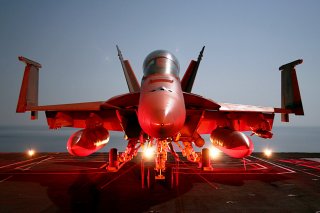Why the U.S. Military Loves Going 'Top Gun' (To Prove a Point)
Flying low to the ground looks great for Hollywood. But it's not just for show.
In a trailer for the upcoming film Top Gun: Maverick, one memorable sequence involves an F-18 Super Hornet flying over the desert – at an extremely low altitude, a wingspan’s distance from the ground. The plane flies close enough to the sand, in fact, that its engines kick up clouds, creating a wake in the dunes similar to a ship’s wake in water.
The reason this stunt is in the trailer is very simple: it looks good. And Hollywood has a well-known disdain for reality: “Never let the truth,” one Hollywood truism goes, “get in the way of a good story.”
But in this case, the producers of Top Gun: Maverick did not have to make a choice between aesthetics and accuracy. Flying extremely low to the ground is, surprisingly, a useful tactic for pilots to develop. Former U.S. Navy pilot John Cheshire explains the point on Quora.
“We flew even lower,” Cheshire said about the movie trailer, “about half that altitude [i.e. the altitude of the plane in the trailer], if not lower. One guy lost his centerline fuel tank because he went too low and it hit the water.”
But why?
Cheshire pointed out that the main advantage of such low flights was to avoid radar detection. Both conventional radar detection and surface-to-air missile (SAM) detection only work above a certain height. When planes fly low, large radar batteries have difficulty spotting them, because they are often concealed by confusing terrain such as mountains or hills.
But he also added that “It was good training to fly that low and become comfortable if we ever needed to fly very low in combat. Also, it was great fun and a rush to experience that amazing speed low to the ground.”
Cheshire describes witnessing similar training during his childhood: “I also remember growing up on an Iowa farm where Cold War B-47s and B-52s would fly extremely low over our farm. They were flying a published low-level training route in preparation for a nuclear strike if ever needed. My parents did not like these very low flyovers, but I loved them.”
The Cold War pilots were training for the same scenario that Cheshire had: that, had a Third World War broken out, it would have been vital to position one’s aircraft as close to the ground as possible to avoid detection.
Fortunately, such tactics were never truly needed during the Cold War – and have not been needed since. Except in movies, that is.
Trevor Filseth is a current and foreign affairs writer at the National Interest.
Image: Flickr

